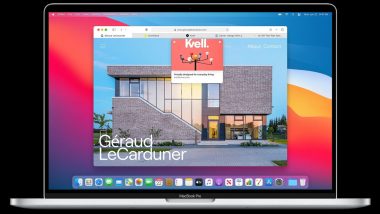Cupertino, June 23: Apple has confirmed its break up with Intel x86 architecture for Advanced RISC Machines (ARM) chips in its Mac desktops, announcing it will transition the Mac to its world-class custom silicon to deliver industry-leading performance and powerful new technologies. Developers can now get started updating their apps to take advantage of the advanced capabilities of Apple silicon in the Mac. WWDC20: Apple Showcases iOS 14, iPadOS 14 and More With Next-Gen Tools in COVID-19 Times.
"From the beginning, the Mac has always embraced big changes to stay at the forefront of personal computing. Today we're announcing our transition to Apple silicon, making this a historic day for the Mac," said Apple CEO Tim Cook. "With its powerful features and industry-leading performance, Apple silicon will make the Mac stronger and more capable than ever. I've never been more excited about the future of the Mac," Cook said during the WWDC20 developer conference late Monday.
Apple plans to ship the first Mac with Apple silicon by the end of the year and complete the transition in about two years. Apple will continue to support and release new versions of macOS for Intel-based Macs for years to come, and has exciting new Intel-based Macs in development.
"The transition to Apple silicon represents the biggest leap ever for the Mac," said the company.
This transition will also establish a common architecture across all Apple products, making it far easier for developers to write and optimise their apps for the entire ecosystem. Apple also introduced macOS Big Sur, the next major release of macOS. Developers can easily convert their existing apps to run on Apple silicon, taking advantage of its powerful technologies and performance. For the first time, developers can make their iOS and iPadOS apps available on the Mac without any modifications.
To help developers get started with Apple silicon, Apple is also launching the Universal App Quick Start Programme, which provides access to documentation, forums support, beta versions of macOS Big Sur and Xcode 12, and the limited use of a Developer Transition Kit (DTK). For over a decade, Apple's class silicon design team has been building and refining Apple SoCs. The result is a scalable architecture custom designed for iPhone, iPad, and Apple Watch that leads the industry in unique features and performance per watt, and makes each of them best in class.
Building upon this architecture, Apple is designing a family of SoCs for the Mac. In macOS Big Sur, Apple is offering a range of technologies to make the transition to Apple silicon smooth and seamless.
"With everything built into Xcode 12, such as native compilers, editors, and debugging tools, most developers will be able to get their apps running in a matter of days," said the company.
(The above story first appeared on LatestLY on Jun 23, 2020 10:35 AM IST. For more news and updates on politics, world, sports, entertainment and lifestyle, log on to our website latestly.com).













 Quickly
Quickly


